Stability in a Simple Food Chain System with Michaelis-Menten Functional Response and Nonlocal Delays
Abstract
This paper is concerned with the asymptotical behavior of solutions to the reaction-diffusion system under homogeneous Neumann boundary condition. By taking food ingestion and species′ moving into account, the model is further coupled with Michaelis-Menten type functional response and nonlocal delay. Sufficient conditions are derived for the global stability of the positive steady state and the semitrivial steady state of the proposed problem by using the Lyapunov functional. Our results show that intraspecific competition benefits the coexistence of prey and predator. Furthermore, the introduction of Michaelis-Menten type functional response positively affects the coexistence of prey and predator, and the nonlocal delay is harmless for stabilities of all nonnegative steady states of the system. Numerical simulations are carried out to illustrate the main results.
1. Introduction
The overall behavior of ecological systems continues to be of great interest to both applied mathematicians and ecologists. Two species predator-prey models have been extensively investigated in the literature. But recently more and more attention has been focused on systems with three or more trophic levels. For example, the predator-prey system for three species with Michaelis-Menten type functional response was studied by many authors [1–4]. However, the systems in [1–4] are either with discrete delay or without delay or without diffusion. In view of individuals taking time to move, spatial dispersal was dealt with by introducing diffusion term to corresponding delayed ODE model in previous literatures, namely, adding a Laplacian term to the ODE model. In recent years, it has been recognized that there are modelling difficulties with this approach. The difficulty is that diffusion and time delay are independent of each other, since individuals have not been at the same point at previous times. Britton [5] made a first comprehensive attempt to address this difficulty by introducing a nonlocal delay; that is, the delay term involves a weighted-temporal average over the whole of the infinite domain and the whole of the previous times.
There are many results for reaction-diffusion equations with nonlocal delays [5–18]. The existence and stability of traveling wave fronts were studied in reaction-diffusion equations with nonlocal delay [5–9]. The stability of impulsive cellular neural networks with time varying was discussed in [10] by means of new Poincare integral inequality. The asymptotic behavior of solutions of the reaction-diffusion equations with nonlocal delay was investigated in [11, 12] by using an iterative technique and in [13–15] by the Lyapunov functional. The stability and Hopf bifurcation were discussed in [16] for a diffusive logistic population model with nonlocal delay effect.
Additionally, (i = 1, 2) represents the nonlocal delay due to the ingestion of predator; that is, mature adult predator can only contribute to the production of predator biomass. The boundary condition in (2) implies that there is no migration across the boundary of Ω.
The main purpose of this paper is to study the global asymptotic behavior of the solution of system (1)–(3). The preliminary results are presented in Section 2. Section 3 contains sufficient conditions for the global asymptotic behaviors of the equilibria of system (1)–(3) by means of the Lyapunov functional. Numerical simulations are carried out to show the feasibility of the conditions in Theorems 8–10 in Section 4. Finally, a brief discussion is given to conclude this work.
2. Preliminary Results
In this section, we present several preliminary results that will be employed in the sequel.
Lemma 1 (see [3].)Let a and b be positive constants. Assume that ϕ, φ ∈ C1(a, +∞), φ(t) ≥ 0, and ϕ is bounded from below. If ϕ′(t)≤−bφ(t) and φ′(t) ≤ K in [a, +∞) for some positive constant K, then lim t→+∞φ(t) = 0.
The following lemma is the Positivity Lemma in [20].
Lemma 2. Let and satisfy
Lemma 3 (see [20].)Let and be a pair of constant vector satisfying and let the reaction functions satisfy local Lipschitz condition with . Then system (1)–(3) admits a unique global solution u(t, x) such that
The following result was obtained by the method of upper and lower solutions and the associated iterations in [21].
Lemma 4 (see [21].)Let be the nontrivial positive solution of the system
- (1)
if B ± A1 > 0, then u → (B ± A1)/A2 uniformly on as t → ∞;
- (2)
if B ± A1 ≤ 0, then u → 0 uniformly on as t → ∞.
Now we prove the following propositions which will be used in the sequel.
Proposition 5. For any nonnegative initial function, the corresponding solution of system (1)–(3) is nonnegative.
Proof. Suppose that (u1, u2, u3) is a solution and satisfies with T ≤ +∞. Choose 0 < τ < T. Then
Proposition 6. System (1)–(3) with initial functions ϕi admits a unique global solution (u1, u2, u3) satisfying 0 ≤ ui(t, x) ≤ Mi for i = 1,2, 3, where Mi is defined as
Proof. It follows from standard PDE theory that there exists a T > 0 such that problem (1)–(3) admits a unique solution in . From Lemma 2 we know that ui(t, x) ≥ 0 for . Considering the first equation in (1), we have
3. Global Stability
In this section, we study the asymptotic behavior of the equilibrium of system (1)–(3). In the beginning, we show the existence and uniqueness of positive steady state.
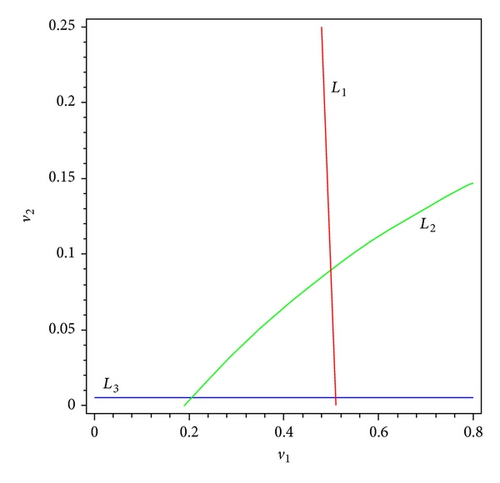
Lemma 7. Assume that H2 and G2 hold, and then the positive steady state E* of system (1)–(3) is locally asymptotically stable.
Proof. We get the local stability of E* by performing a linearization and analyzing the corresponding characteristic equation. Similarly as in [22], let 0 < μ1 < μ2 < μ3 < … be the eigenvalues of −Δ on Ω with the homogeneous Neumann boundary condition. Let E(μi) be the eigenspace corresponding to μi in , for i = 1,2, 3, … . Let
By continuity of the roots with respect to μi and Routh-Hurwitz criterion, we can conclude that there exists a positive constant ε such that
Theorem 8. Assume that
Proof. It is easy to see that the equations in (1) can be rewritten as
From Proposition 6 we can see that the solution of system (1) and (3) is bounded, and so are the derivatives of (i = 1, 2, 3) by the equations in (1). Applying Lemma 1, we obtain that
Furthermore, the local stability of E* combining with (43) gives the following global stability.
Theorem 9. Assume that
Proof. It is obvious that system (1)–(3) always has two non-negative equilibria (u1, u2, u3) as follows: E0 = (0, 0, 0) and E1 = (a1/a11, 0, 0). If H1 and H4 are satisfied, system (1) has the other semitrivial solution denoted by , where
We consider the stability of E2 under condition H1 and H4. Equation (1) can be rewritten as
Theorem 10. Suppose that G5 and G6 hold, and then the semi-trivial steady state E1 of system (1)–(3) with non-trivial initial functions is globally asymptotically stable.
Proof. We study the stability of the semi-trivial solution . Similarly, the equations in (1) can be written as
4. Numerical Illustrations
In this section, we perform numerical simulations to illustrate the theoretical results given in Section 3.
Example 12. Let a11 = 53/9, a21 = 81/13, a3 = 1/13 and a32 = 14. Then it is easy to see that the system admits a unique positive equilibrium E*(1/2,1/12,1/12). By Theorem 8, we see that the positive solution (u1(t, x), u2(t, x), u3(t, x)) of system (1)–(3) converges to E* as t → ∞. See Figure 2.
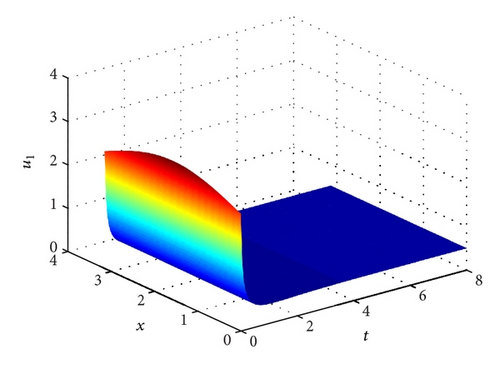
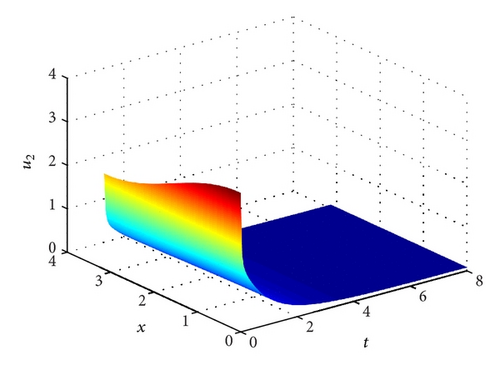
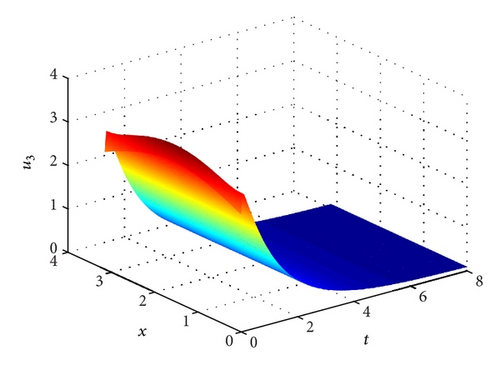
Example 13. Let a11 = 6, a21 = 12, a3 = 1/4 and a32 = 1. Clearly, H2 does not hold. Hence, the positive steady state is not feasible. System (1) admits two semi-trivial steady state E2(0.4732,0.2372,0) and E1(1/2,0, 0). According to Theorem 9, we know that the positive solution (u1(t, x), u2(t, x), u3(t, x)) of system (1)–(3) converges to E2 as t → ∞. See Figure 3.
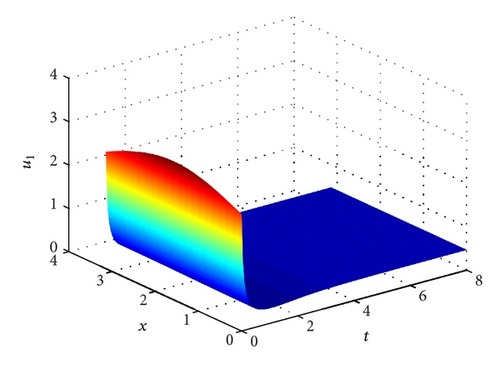
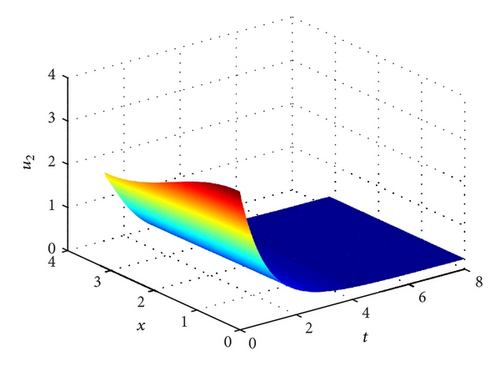
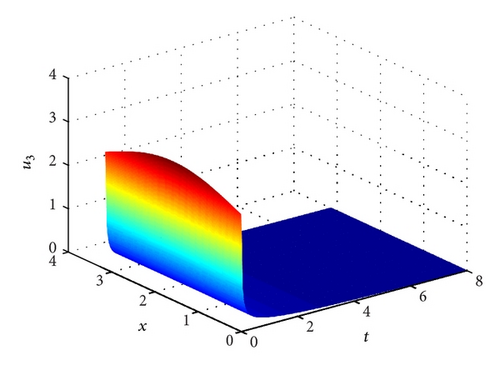
Example 14. Let a11 = 6, a21 = 2, a3 = 1/4 and a32 = 1. Clearly, H1 does not hold. Hence, E* and E2 are not feasible. System (1) has a unique semi-trivial steady state E1(1/2,0, 0). According to Theorem 10 we know that the positive solution (u1(t, x), u2(t, x), u3(t, x)) of system (1)–(3) converges to E1 as t → ∞. See Figure 4.
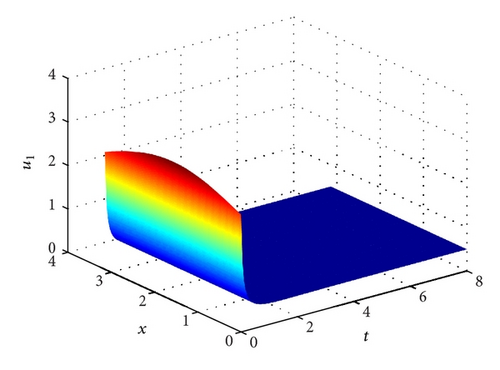
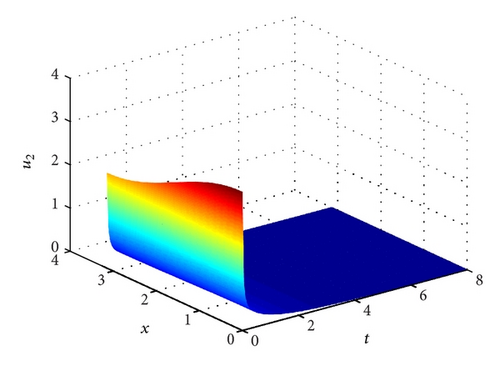
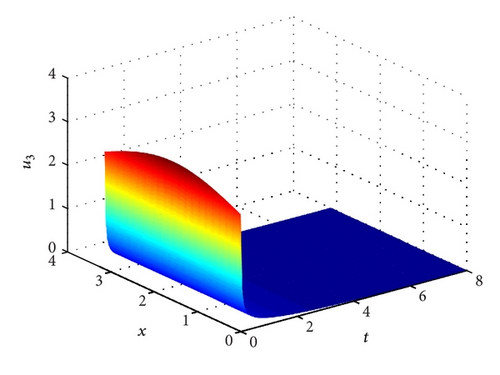
5. Discussion
In this paper, we incorporate nonlocal delay into a three-species food chain model with Michaelis-Menten functional response to represent a delay due to the gestation of the predator. The conditions, under which the spatial homogeneous equilibria are asymptotically stable, are given by using the Lyapunov functional.
We now summarize the ecological meanings of our theoretical results. Firstly, the positive equilibrium E* of system (1)–(3) exists under the high birth rate of the prey (a1) and low death rates (a2 and a3) of predator and top predator. E* is globally stable if the intraspecific competition a11 is neither too big nor too small and the maximum harvest rates a12, a23 are small enough. Secondly, the semi-trivial equilibrium E2 of system (1)–(3) exists if the birth rate of the prey (a1) is high, death rate of predator a2 is low, and the death rate (a3) exceeds the conversion rate from predator to top predator (a32). E2 is globally stable if the maximum harvest rates a12, a23 are small and the intra-specific competition a11 is neither too big nor too small. Thirdly, system (1)–(3) has only one semi-trivial equilibrium E1 when the death rate (a2) exceeds the conversion rate from prey to predator (a21). E1 is globally stable if intra-specific competitions (a11, a22, and a33) are strong. Finally, E0 is unstable and the non-stability of trivial equilibrium tells us that not all of the populations go to extinction. Furthermore, our main results imply that the nonlocal delay is harmless for stabilities of all non-negative steady states of system (1)–(3).
There are still many interesting and challenging problems with respect to system (1)–(3), for example, the permanence and stability of periodic solution or almost periodic solution. These problems are clearly worthy for further investigations.
Acknowledgments
This work is partially supported by PRC Grants NSFC 11102076 and 11071209 and NSF of the Higher Education Institutions of Jiangsu Province (12KJD110002 and 12KJD110008).




